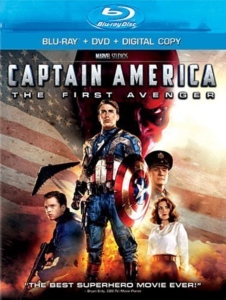This blog series chronicles my first viewing of the complete MCU movie saga. I’ll examine each film under various categories that reflect popular discussion points. Next up is the fifth film, “Captain America: The First Avenger” (2011):
STRENGTHS
Under the direction of “Star Wars” special effects veteran Joe Johnston (who also helmed “Jurassic Park III,” but we won’t dwell on that), “Captain America: The First Avenger” has the same filmmaking confidence as “Incredible Hulk” in terms of sights and sounds, but a less predictable plot.
The title character could have been jingoistic, but he is a free-thinking individual. The special effects are masterful, whether it’s convincingly grafting Chris Evans’ face onto a skinny actor before Steve Rogers’ transformation, or the fun action scenes of Cap using his boomerang shield.

“Captain America: The First Avenger” (2011)
Director: Joe Johnston
Writers: Christopher Markus, Stephen McFeely, Joe Simon
Stars: Chris Evans, Hugo Weaving, Samuel L. Jackson
WEAKNESSES
Before doing post-film research and talking to RFMC MCU expert Michael Olinger, I found some of the specifics confusing, such as Agent Carter’s role within the military structure, the nature of Hyrda’s relationship with the Nazis, and whether Cap was found frozen in the ice in the 1940s or in present day.
HEROES
Steve Rogers/Captain America (Evans) is the symbol of American ideals, which should make him the most cartoonish hero so far. Under the confident pen of Christopher Markus and Stephen McFeely, the opposite is the case. As a skinny lad, he has learned to hate bullies, so he wants to stop the Nazis. Even after he gets buff thanks to a successful U.S. military lab experiment, we believe he isn’t driven by bloodlust, but rather out of desire to save the victims of Nazism, plus U.S. Army captives – namely his best friend, Bucky (Sebastian Stan).
VILLAINS
As “Raiders of the Lost Ark” proved, Nazis are ideal if you need the audience to hate the villains without wanting to devise a backstory. Operating as a shadow organization related to the Nazis’ WWII strategy is the secret international syndicate Hydra, led by Johann Schmidt, a.k.a. Red Skull (Hugo Weaving). But these guys still have Nazi accents, so the original point remains even as the story expands to wider comic-book lore.
WOMEN
There’s only one named female character, so “Captain America” fails the Bechdel Test. But she is the MCU’s best female character so far: Agent Peggy Carter (Hayley Atwell), the Strategic Scientific Reserve’s military liaison.
The way she and Steve are drawn to each other is a very natural love story that taps into a 1940s film aesthetic. And while we don’t learn anything about her other than her job and her attraction to Steve (and she ultimately is knocked out of the MCU film narrative due to Steve’s time-jump), Marvel aimed to rectify that with the TV series “Agent Carter” (2015-16).

MIRROR TO REALITY
Although I’m sure it’s not intended, “Captain America” can be read as a pro-steroids film, as it’s about a skinny boy who – rather than going to the gym to work on his physique – gets enhanced by the military’s cutting-edge technology. It’s a classic comic-book idea that being muscular is the key to success in all aspects of life, dating back to comics’ ubiquitous Charles Atlas ads. So it’s no surprise that the oldest Avenger (invented in 1941) embodies that ideal.
“Captain America” is structured as a war propaganda film, but with the superhero aspects smoothly integrated. Since it takes place among the “last good war” and most of the villains are the thickly accented movie Nazis you’d expect, the warmongering and jingoism aren’t too jarring. In fact, Cap himself is irked by the war bond-promotion stage shows of which he is the centerpiece.
BEST ACTION SCENE
As Cap and his allies storm Red Skull’s compound, we get a thrilling motorcycle pursuit, and Cap uses his shield both as a deflector and as a vicious boomerang. It’s peppered by soldiers getting disintegrated by the high-tech guns Hydra developed. This is a war movie, but mostly an accessible comic-book movie, as this sequence showcases.
BEST COMEDIC MOMENT
Riding in a cab with Agent Carter, Steve stumbles through calling her a “dame” and “beautiful” and “an agent,” but in an oddly charming way the fits with the future buff version of himself.
Peggy: You have no idea how to talk to a woman, do you?
Steve: I think this is the longest conversation I’ve had with one. Women aren’t exactly lining up to dance with a guy they might step on.
WORLD BUILDING
“Captain America” does the most world building of any MCU film so far. We are introduced to Hydra, which aims to wipe out all nations and rule the world. And Agent Carter is a precursor to Agent Coulson, with the Strategic Scientific Reserve being a precursor to S.H.I.E.L.D. Tony Stark’s dad, Howard (Dominic Cooper), creates Captain America’s shield out of a rare metal, which explains why we see an old prototype of the shield in Tony’s lab in “Iron Man 2.”
FINAL THOUGHTS/EXPECTATIONS
Thanks to Evans and the script, Captain America is the most compelling of the four Avengers to get introductory films. But I like all four of them, plus Black Widow, introduced in “Iron Man 2.” (We don’t know much about Hawkeye at this point.) I am looking forward to seeing this sextet interact in “The Avengers,” and I’ve heard that the “Captain America” sequels are even better than this original entry, so I’m on board for those, too.

